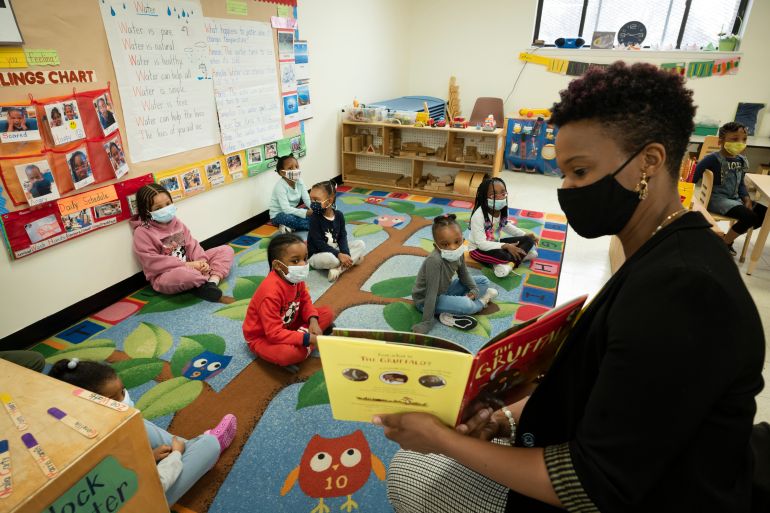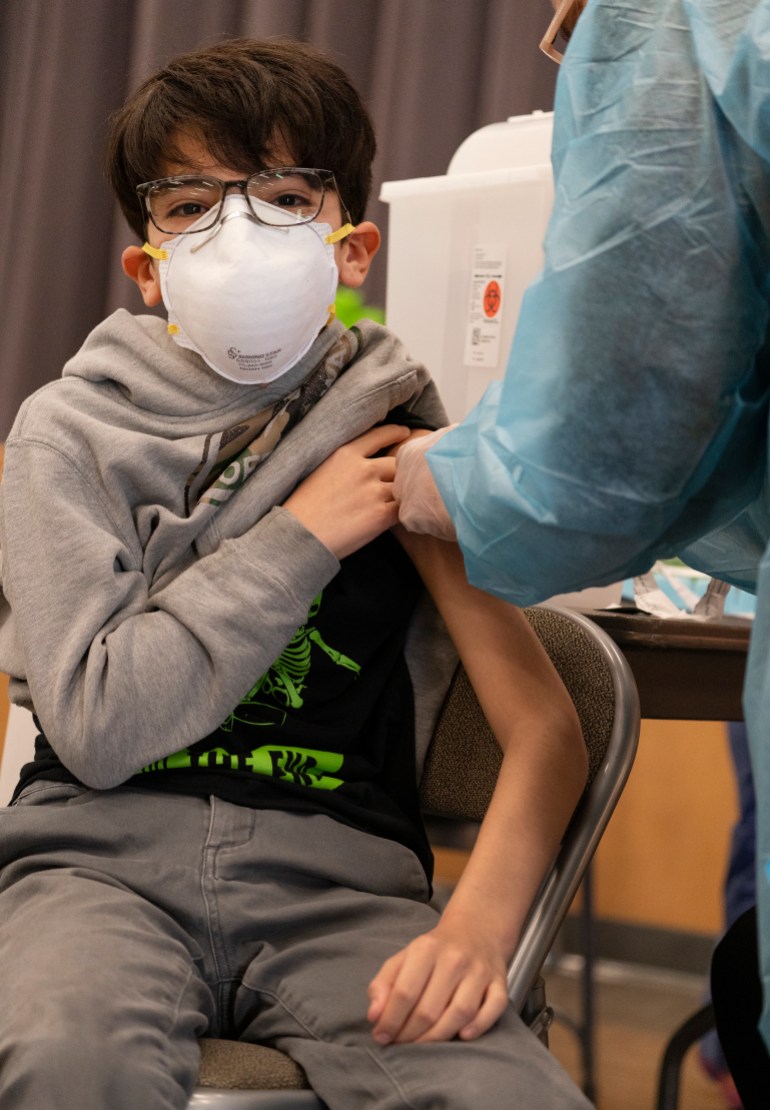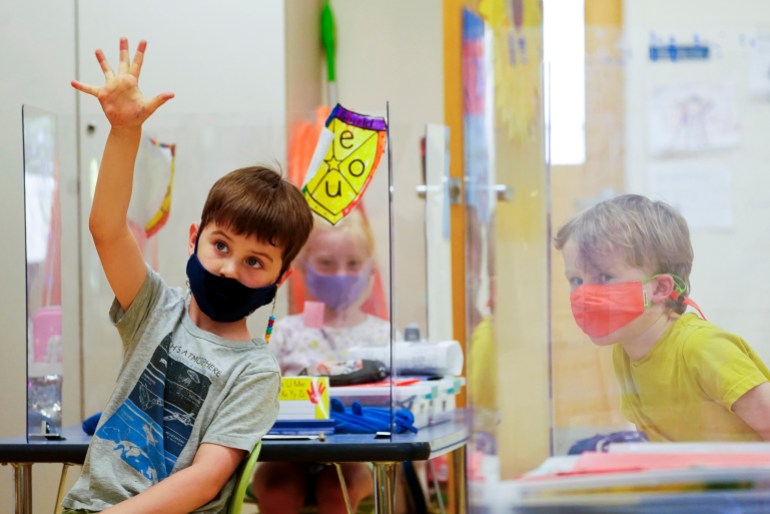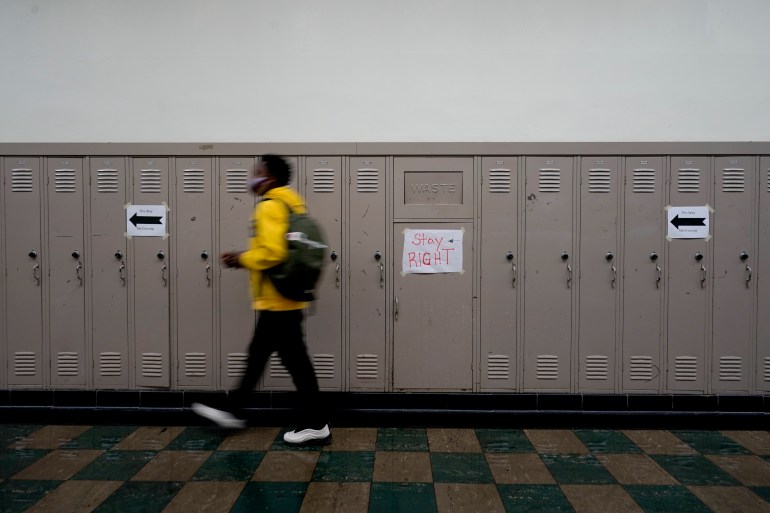What will public school look like for US students this fall?
Will kids have to wear masks when they return to school this fall? Will coronavirus vaccines be required? Parents in the US are grappling with uncertainty — and exploring their options.

As mask mandates are dropped in many public places in the United States and coronavirus vaccines become available for Americans aged 11 and up, many parents are wondering if their children will finally head back to the classroom this fall.
There are still plenty of variables. Despite the fact that clinical trials are under way in younger children aged six months to 11 years, there’s no firm timeline as to when vaccines will be widely available for kids — and some parents have been hesitant to have their young children receive COVID-19 shots at all.
Keep reading
list of 4 itemsUS state of Alabama lifts ban on yoga in public schools
‘Critical race theory’ becomes a flashpoint in US public schools
Not working: More US moms dropped out in remote-school states
Then there are concerns about the spread of new strains like the Delta variant, which could force restrictions again.
All of these factors have led to major uncertainty surrounding the 2021-to-2022 school year, which will begin for some states as early as mid-August.

Some governors, like New Jersey’s Phil Murphy, have been adamant that after a year of offering hybrid and remote learning options, in-person schooling will resume in the fall, regardless of the vaccination status of students.
Science supports these types of back-to-the-classroom mandates. A new study published in the Annals of Internal Medicine has found that with controlled community transmission and moderate mitigation strategies — including teacher vaccinations, reduced class sizes, and asymptomatic screening — elementary schools can safely reopen.
Economists are also adamant that reopening in-person schools and childcare centres is crucial to getting American parents back to work and keeping the US recovery on track after a record number of women left the labour force to care for their kids during the coronavirus pandemic.
But while some parents have rejoiced at the prospect of putting their kids on the school bus again, others are apprehensive about what this year might look like.
In-person concerns
Rhiannon Bettivia, the mother of an elementary-age child in a suburb outside of Boston, Massachusetts, fears that a full fall reopening may mean losing mask mandates — which could lead to her reassessing the best option for her son.
“My kid is not going back to school without masks,” Bettivia told Al Jazeera, calling her son’s school mask and social distancing policies this year “draconian but necessary”.
“The science is clear that they work,” she said, adding that she wishes a mask mandate could continue indefinitely for school-aged kids.
“I vote for perpetual masks,” Bettivia said. “I did not miss getting the flu and strep this year.”
Students are remarkably resilient ... However, we also need to consider what we need to do to make up for lost learning time, which has disproportionately impacted children of colour.
Other parents worry that vaccines may become mandatory, a fear held even by parents who are generally pro-vaccine.
“I got the vaccine, but the vaccine trial period was way too short for children,” Chrissy Thomas, a mom of one vaccine-eligible middle schooler who lives in Jersey City, New Jersey, told Al Jazeera.
She is primarily concerned about myocarditis, a rare heart infection. The US Centers for Disease Control and Prevention has confirmed that myocarditis has occurred in 226 people under 30 who have received the COVID-19 vaccination.
With rumours flying online and no official word in many districts on whether vaccines will be required or just recommended, parents find themselves looking for answers and feeling like they’re being left in limbo.
A ‘new normal’
Other parents who watched their children adapt well to remote or hybrid learning models are now looking for a “new normal” when it comes to education.
Stride, Inc, a for-profit company that sells online learning solutions to state and local governments, conducted a survey with third-party research provider Qualtrics asking more than 1,000 US parents how the pandemic had shaped their views on education.

Nearly two-thirds of the parents of students in kindergarten through 12th grade surveyed said US schools have shown they are ill-prepared to shift from in-person learning to online learning again if necessary this fall, and more than 70 percent said they would consider a hybrid model that blends “online and in-person learning”.
The study found this willingness may be anchored in concerns about the ability of public schools to quickly pivot to remote learning again if they need to, Kevin Chavous, president of academic policy and external affairs at Stride, told Al Jazeera.
Indeed, the COVID-19 crisis and education disruption have led to an explosion of private educational technology solutions for families.
Rebecca Mannis, founder and learning specialist at Ivy Prep Learning Center, said the pandemic has given parents a unique window into their children’s educational styles while they learned from home.
Her Manhattan-based educational enrichment centre creates individual education plans for students, and Mannis has seen how staying home with their kids has given parents insight into what they do — and don’t — need in an optimal learning environment.
“Certain children actually did better than they did in recent years, though the reasons for this are vast,” Mannis told Al Jazeera. “For some, it was due to fewer transitions or fewer homework demands. For some students, having less distractions in the classroom or parents who travelled less enabled them to have more structure.”
My kid is not going back to school without masks ... I vote for perpetual masks. I did not miss getting the flu and strep this year.
These observations, Mannis explained, have led some parents to consider ways to optimise their child’s learning in the new school year, regardless of COVID-19 concerns.
“Even very intelligent parents are overwhelmed, and they are looking for someone who can incorporate their observations to create a plan that addresses the concerns they witnessed during this intense year,” explained Mannis, who added this can lead to unscrupulous companies popping up and taking advantage.
“The field of education and tutoring is largely an unlicenced field with lots of biases that educators or ‘homework helpers’ bring to this process, whether in Dubai, Dallas, Doha or Deer Valley,” Mannis noted, adding that quality control will likely be of prime concern for parents in the years ahead.
Education inequity
The proliferation of for-profit enrichment centres, both online and in person, has made some parents and policymakers concerned that they are bolstering a two-tier system where wealthy families will be able to get the resources they can afford, leaving other kids behind.
Research has found that the COVID-19 epidemic has exacerbated the educational equity crisis, with vulnerable, low-income students more likely to fall behind.
A study from Policy Analysis for California Education published in April found that while some socially economically disadvantaged students lost learning, some of their wealthier counterparts actually accelerated their learning during this past year.
The report recommended “a systemic transformation in how schools address the overlapping learning, behavioral, and emotional needs that support effective learning and teaching”.
Certain children actually did better than they did in recent years, though the reasons for this are vast. For some, it was due to fewer transitions or fewer homework demands. For some students, having less distractions in the classroom or parents who travelled less enabled them to have more structure.
Zora Wolfe, the director of K-12 educational leadership programmes and an associate professor of education at Widener University, believes that addressing this inequity is paramount.
“Students are remarkably resilient,” Wolfe told Al Jazeera, adding that “we need to be intentional not to slide back to what we used to do” when that wasn’t working.
“However, we also need to consider what we need to do to make up for lost learning time, which has disproportionately impacted children of colour,” she said.

The solution may be turning to tech, Troy Wheeler, president of the Ed-Fi Alliance, a non-profit community-led organisation that connects educational stakeholders with data tools, told Al Jazeera.
He believes that relying on data to standardise and compare metrics will be key in helping to ensure equity.
“Reliance on actionable data helps teachers to effectively and efficiently guide learners and ensure equitable education across modalities,” Wheeler said. “District leaders are then able to keep a pulse on each student’s academic situation to prevent learning loss and ensure favourable outcomes.”
And while the upcoming school year may “look” more normal than the 2020 school year — regardless of where mask mandates and vaccine requirements may land — this past year may have permanently transformed the educational landscape for parents, teachers and students alike.